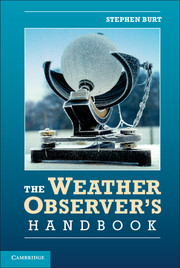Book contents
- Frontmatter
- Contents
- Acknowledgements
- Abbreviations, footnotes and references
- Part One The basics
- Part Two Measuring the weather
- 5 Measuring the temperature of the air
- 6 Measuring precipitation
- 7 Measuring atmospheric pressure
- 8 Measuring humidity
- 9 Measuring wind speed and direction
- 10 Measuring grass and earth temperatures
- 11 Measuring sunshine and solar radiation
- 12 Observing hours and time standards
- 13 Dataloggers and AWS software
- 14 Non-instrumental weather observing
- 15 Calibration
- 16 Metadata – what is it, and why is it important?
- Part Three Making the most of your observations
- Appendix 1 Metrology and meteorology: The basics of instrument theory
- Appendix 2 Useful functions
- Appendix 3 Unit conversions
- Appendix 4 Useful sources
- Index
- References
6 - Measuring precipitation
Published online by Cambridge University Press: 05 July 2012
- Frontmatter
- Contents
- Acknowledgements
- Abbreviations, footnotes and references
- Part One The basics
- Part Two Measuring the weather
- 5 Measuring the temperature of the air
- 6 Measuring precipitation
- 7 Measuring atmospheric pressure
- 8 Measuring humidity
- 9 Measuring wind speed and direction
- 10 Measuring grass and earth temperatures
- 11 Measuring sunshine and solar radiation
- 12 Observing hours and time standards
- 13 Dataloggers and AWS software
- 14 Non-instrumental weather observing
- 15 Calibration
- 16 Metadata – what is it, and why is it important?
- Part Three Making the most of your observations
- Appendix 1 Metrology and meteorology: The basics of instrument theory
- Appendix 2 Useful functions
- Appendix 3 Unit conversions
- Appendix 4 Useful sources
- Index
- References
Summary
Determining some measure of the amount of precipitation (the term includes rain, drizzle, snow, sleet, hail and so on as well as – occasionally – smaller contributions from dew, frost or fog) is not difficult: almost any bucket left out in the rain will suffice. Obtaining accurate, consistent and comparable measurements does, however, require a little more care and sophistication in technique. This chapter outlines methods for doing so, based upon World Meteorological Organization (WMO) recommendations on siting and instruments [1], and discusses some of the pitfalls involved. Making precipitation measurements in snowfall is also covered. A brief ‘One minute summary’ completes the chapter.
Precipitation is one of the most variable of all weather elements, in both space and time. For this reason most countries have a greater density of precipitation measurement locations than other meteorological variables, such as air temperature or solar radiation. More recently, the spatial coverage of precipitation measurements has been considerably improved by radar and satellite remote sensing techniques, but these still rely upon accurate ‘ground truth’ observations for calibration and quality control. However, precipitation measurements are very sensitive to exposure – particularly to the wind – and it can be difficult to derive measurements representative of an area from the spot values provided by a ground-based sensor, particularly in urban areas or those with complex topography. Precipitation measurement networks tend to be densest in well-populated areas of gentle terrain rather than in remote mountainous areas with complex topography and harsher weather. Unfortunately, the latter are often the areas with highest annual average precipitation and/or snowfall, and may well be the prime source of a city or region’s water resources, requiring careful and consistent long-term measurements.
- Type
- Chapter
- Information
- The Weather Observer's Handbook , pp. 124 - 166Publisher: Cambridge University PressPrint publication year: 2012



